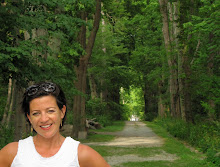
This specimen is turning yellow, but you can find sugar maples turn fiery orange and red as well.
A commenter asked earlier this week why leaves turn different colors in the fall, and now I'm going to attempt to answer in just a few short sentences....

Most people know that chlorophyll is the chemical compound in plants that is necessary for photosynthesis (the production of sugars and carbon dioxide in a plant). Chlorophyll is also a pigment that absorbs the blue and yellow colors from sunlight, making plants appear green. The more chlorophyll in a plant, the more green it appears (and also, the more energy it produces and in some cases, the faster it grows -- it's generally why green-leaved plants grow faster than their variegated counterparts).
In the fall - as the days become shorter and colder - a membrane grows between the twig and the leaf petiole which clogs up the flow of sugars and water between the leaf and the rest of the tree. This eventually prevents the chlorophyll from being productive and the compound breaks down.
That's where carotenes and anthocyanins - two other pigments in leaves - come in to play. These pigments exist in the leaf all year, but are overpowered by the presence of chlorophyll until autumn. The former absorbs blue-green and blue light, which means that the presence of carotene - once the chlorophyll is gone - can make a leaf look yellow. Anthocyanins absorb blue, blue-green and green light, which makes a leaf appear red. The amount of anthocyanins and carotene varies among species (and in the case of sugar maples, they vary among individual plants).

So now, when you see a tree that has yellow fall color, you can impress your friends by observing that said tree must have a high concentration of carotene. I'm sure they'll be fascinated!
Back to sugar maples, briefly. Sugar maples of course are responsible for maple syrup and, as the common name would imply, the tree's sap is quite sweet. They are also very hard-wooded trees and the lumber is used for basketball court floors, pool cues and bowling pins.
My students struggle with discerning differences between sugar, silver, Norway and red maples. I'll post some of these other species in the days to come. The important characteristics to look for in sugar maples are a smooth or entire leaf margin and furrowed bark. While Norway maples also have entire margins, their bark is more stripey (and the leaf petiole exudes a white milky substance). Unlike sugar maples, red maples have serrated edges and silver maples have deep leaf sinuses.
Acer comes from a Latin word for sharp - referring to the hard wood, which could be utilized to make spears. Saccharum means 'sugar' - like saccharine.
























.jpg)





















